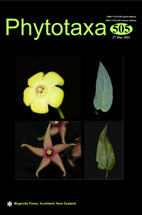Abstract
Taxonomic studies of Mimosa subser. Polycephalae revealed a new species and indicated the need for taxonomic and nomenclatural adjustments in the group. Mimosa pseudoracemosa is described and illustrated as a new species from Goiás State in central-western Brazil. We discuss its geographic distribution, environmental preferences, phenology and conservation status and compare it with the morphologically similar M. pseudoradula and M. flavocaesia. A new status for M. pseudoradula var. detonsa and a new name are proposed (= M. detonsa), including M. pseudoradula var. anapolitana and M. pseudoradula var. crystallites as its synonyms, as well an updated circumscription for M. pseudoradula without the admission of varieties. We also present descriptions, images, maps, comments on their distributions and morphological relationships, flowering and fruiting periods, and conservation statuses. In addition to the morphological and geographic discontinuities of the aforementioned taxa, their trichome micromorphology supported the establishment of the new species, as well as the taxonomic decisions involving M. pseudoradula.

